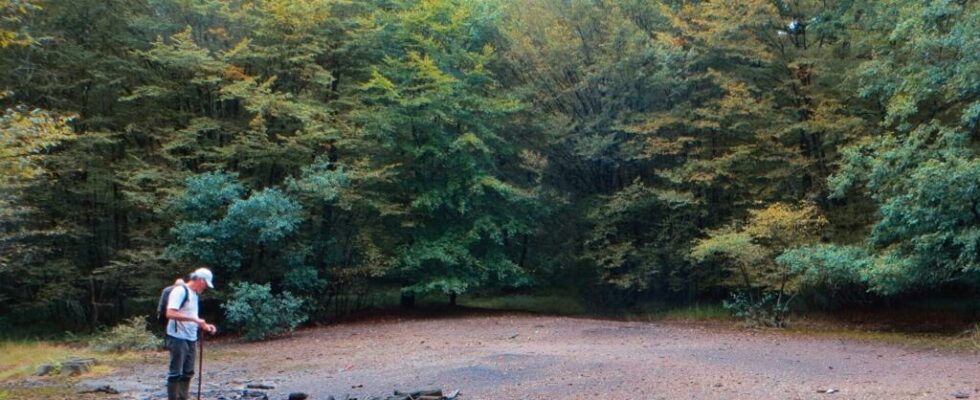Near Verdun, the Spincourt forest is home to a 1,000 m2 clearing where nothing has grown for a century. Often overlooked, the environmental consequences of armed conflicts remain colossal. And durable. One hundred and ten years after the outbreak of the First World War, certain front zones still remain inaccessible. Insights, with the geologist and doctoral student in history, Daniel Hubé.
5 mins
Soon, a dome will be placed on the site. This clearing in the Spincourt forest bears the scars of a conflict which tormented the land, as much as the bodies. Almost a hundred years ago, more than 200,000 chemical arsenic shells from the German army were destroyed there, for lack of an alternative. The area is toxic, closed to the public. The surrounding residents gave it a name: the “gas square”.
Undeniably, the World War I defined a new way of fighting. Over the course of the entire conflict, more than two billion artillery pieces were fired on the Western Front. Among them, many did not explode at the time. In the months following the armistice, residents of former combat zones experienced incessant risk and daily accidents. In 1929, in the Meuse alone, there were 127 salvagers and fireworks killed in the process of securing former battlefields. And the danger still runs. “ We still dig up machines in very good condition », Says geologist Daniel Hubé. “ In several places, we are literally walking on shells. »
Very quickly after the conflict, “red zones” were demarcated by the authorities. Given the danger, many activities were temporarily or permanently prohibited there. But voices were raised. State services were under strong pressure to reduce the size of the prohibited zones. The farmers of Pas-de-Calais, in particular, were impatient to put certain particularly fertile lands back into cultivation. In this department, the “red zone” measured 26,000 hectares at the end of the conflict, compared to only 472 hectares four years later. The message had been heard.
“ The end of the war was more polluting than the war itself »
Never in history has a country had to eliminate such a quantity of weapons in such a short time. The staffs had maintained their firepower, preparing for a final offensive in the summer of 1919. The bugle call that sounded on November 11, 1918 took everyone by surprise. Fields and factories found themselves cluttered with stocks of weapons, which there was no choice but to get rid of. Two million tons of munitions were reportedly destroyed in France in the interwar period. “ The end of the conflict was more polluting than the war itself », says Daniel Hubé. Before continuing: “ The cleaning of the battlefields was paradoxically very polluting. »
Initially, the armies mobilized prisoners of war to blow up a significant portion of the remaining munitions. These “fire cracking” operations, most often carried out in former combat zones, ravaged natural spaces already damaged by four years of industrial war. Other shells, sometimes chemical, were buried in the sea or lakes. Overwhelmed, the State decided in 1920 to delegate this destruction of weapons to private operators. Some long-toothed industrialists made their fortune.
A slow realization
In the second half of the 20th century, the development of various leisure activities, such as caving and scuba diving, led to the discovery of numerous buried or submerged munitions. The authorities realized the extent of the damage from the 1990s. Remediation work was undertaken on the most contaminated sites, such as Lake Gérardmer in the Vosges, or that of Bleu d’Avrillé in Maine-et-Loire. .
Today, the question of the environmental consequences of conflicts has gained momentum. Since 1999, the United Nations have published more than twenty reports on the subject. War in Kosovo, Ukraine or Gaza : the organization has studied them all, with the objective of designing international law reducing environmental damage in times of war.
Seven hundred years to purge the soil of France of buried munitions
In 2011, the discovery of perchlorate ions in tap water in several territories in the North and Northeast sparked controversy. And for good reason, the map of the affected areas largely coincided with that of the front zones of the Great War. Just a coincidence? Daniel Hubé remains skeptical. “ This contamination is likely linked to perchlorate explosives left on battlefields and munitions destruction sites “, he explains. “ But an agricultural origin is also possible. » In the fall of 2012, the drinking water of more than 500 municipalities in the Nord and Pas-de-Calais was declared unfit for consumption. Ten years later, doubt persists.
French soil, as a whole, remains deeply marked by the war. “ There is no other country on Earth that has experienced three major interstate conflicts on its territory in less than a century. », summarizes Daniel Hubé. Civil Security estimates that it will take 700 years to completely purge the soil of France of the munitions buried there. There is work to be done.
